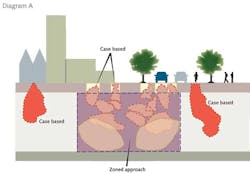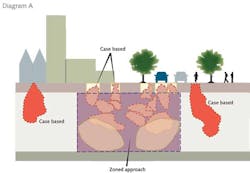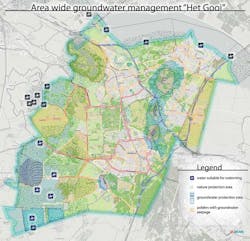Groundwater Energy and Remediation: Realising the Synergy in The Netherlands
A zoned approach to groundwater management allows for functional use while allowing natural attenuation processes to contain contamination. Hans Slenders looks at how projects in Utrecht and Gooi in the Netherlands are proving how a risk-based approach is helping utilities to improve groundwater quality.
Contaminated groundwater lies beneath most heavily urbanised areas in delta regions. Over the centuries, pollutants have seeped into the subsoil and created plumes of contamination within aquifers and gradually dispersed over a wider area. This threatens the quality of surrounding groundwater wells and surface water and potentially makes them unsafe for humans or harmful to the environment.
In inner city areas, the management and remediation of polluted groundwater is typically limited by cost and technical challenges, and may take decades to yield results. Traditional solutions are therefore not viable for a large portion of contaminated plumes, making it difficult to improve groundwater quality or to protect vulnerable areas. Furthermore, in a traditional approach, the effective use of groundwater is often unattainable, because moving and spreading contaminants is prohibited.
In the Netherlands, where there are around 100 and 150 large scale contaminated groundwater areas, the Dutch government has made remediation a priority and established ambitious cleanup goals for 2015. These efforts have met a number of bottlenecks and cost constraints. New incentives are required to address the liability and reach the 2015 goal.
Water to energy
A parallel development in groundwater management has been the growing demand for sustainable energy, and the use of subsurface water to create heat cold storage (HCS) or Aquifer Thermal Energy Systems (ATES) for the buildings on the surface. As a result, upwards of 1,500 HCS systems have been created in the Netherlands, with plans to dramatically increase their numbers in the next decade. These initiatives are frequently being employed in dense urban areas, where there are offices and other buildings, but where historical groundwater contaminants are also present.
Over the last decade, these developments have resulted in a more pragmatic risk-based approach to groundwater quality management that aims to benefit from its use and improve cost-efficiency, while still protecting human health and helping groundwater quality. It is based on three pillars:
1) Protect: protect the environment and contain contaminated groundwater to prevent further spreading
2) Use: benefit from groundwater's potential e.g. as a sustainable form of energy supply to heat buildings
3) Improve: enhance the quality of groundwater, by active measures, or by optimising the conditions for the natural breakdown of contaminants over time.
Heat cold storage systems can be used to contain, control, or sustainably remediate groundwater. However, their implementation also presents considerable challenges. Energy from HCS is obtained by pumping large flows of groundwater and extracting hot or cold energy with a heat pump. As groundwater is pumped from a cold zone to a warm zone, contaminants are also moved around.
This is contrary to the remediation goal of containing the spread of contaminants. In the Netherlands the Dutch Soil Protection Law, and on a European Level, the Groundwater Daughter Directive, strictly limit the additional movement of contaminants. This hurdle can only be overcome if the necessary large flows are used to contain the contaminants as part of an overall HCS system.
In the Netherlands, the combination of these two concepts also entails working with different authorities to secure the necessary permits. Remediation work falls under the jurisdiction of the municipality. Groundwater energy, on the other hand, is the responsibility of the province.
Finally, there are also considerable engineering challenges. Within an HCS system, the flow in the extraction wells is determined by the energy demands of the buildings. However, remediation requires that flows are used to contain contaminated groundwater and to manipulate the groundwater flow field.
Reconciling the demand for energy with the need for containment is a complex but essential task. It requires another conceptual way of thinking, and a smart design of the system; coupling of wells; management of pumps, sensors, the in-house installations; and that many other areas are highly coordinated with each other.
Utrecht: an example of a zoned approach
The inner city of Utrecht has been undergoing major renovation work in recent years, across a sizable area, which has led to a number of activities involving the subsurface.
These include groundwater extractions for building excavations, and the development of underground infrastructures and HCS systems to cool and heat new offices and buildings. As an historic city, Utrecht has been home to many industrial activities in the past. As a result, its groundwater is extensively contaminated. There is an estimated 50 million m3 of groundwater in the aquifer where HCS systems have been planned. This aquifer comprises some 29 sources and plumes that are polluted with chlorinated solvents and other chemicals, which are often intermingled.
Some 20 HCS systems are being employed or are planned, ranging from 5 m to 50 m below ground surface, across an area of roughly 6 km2. This has presented a major obstacle, given the ban on the migration of contaminated water, while remediation work would be too expensive and time consuming to implement effectively on a case-by-case basis due to the interaction between plumes.
The breakthrough came in 2010, with the approval of a new Remedial Action Plan for the area. The municipality worked hard on necessary policy interpretations and initiated the actual planning and design. The Remedial Plan allowed for an area wide approach; a defined system area, or management zone, within which groundwater contaminants would be allowed to move and mix, to allow for the establishment of HCS systems.
An important aspect of this approach is that shallow sources of contaminants in the soil and the deeper contaminated groundwater areas are being treated separately. The area wide approach is only applied to the deeper groundwater contamination. The reason for this is that the risks at ground level belong to the shallow sources (<5 m) and remain the responsibility of the site owner.
At this shallow level, the different contaminant cases can still be differentiated. Therefore, the relation between the contamination and the original source locations were still evident, making a case-based, location-specific approach viable. By contrast, in the deeper groundwater, the connection between the original source and the mixed plumes is not evident, as the plume extent is often underneath the properties of other parties. The risks of the contaminants are completely different.
A zoned approach to groundwater management therefore allows for its functional use while permitting natural attenuation processes to contain the extent of the contamination and keep it at a stable level. By letting go of individual cases of contamination and looking at the bigger picture, Utrecht was able to make a more efficient use of the subsurface and gain access to renewable energy.
Increased degradation
However, the benefits of HCS systems on contaminated groundwater do not end there. There is now clear evidence to indicate that although HCS systems extend the borders of contaminated plumes, the overall quality of the groundwater improves over time as a result. This is because of the increasing contact between contaminants, nutrients and naturally occurring bacteria, as the groundwater mixes through pumping.
On the Utrecht site, even using very conservative degradation constants, the total amount of chlorinated solvents is expected to decrease from approximately 6,000 kg to 4,000 kg over a 30-year period; a significant improvement in groundwater quality.
This is a conservative estimate; in the meantime, at the Philips site in Eindhoven, monitoring has showed that the HCS system has led to a 1,000 times increase in the microbial presence of specific degraders.
The Utrecht Remedial Action Plan was a crucial step forward that is helping improve groundwater quality, while protecting clean areas. Furthermore, it is estimated that the Heat Cold Storages will lead to 30- 50% reduction of CO2 and non-renewable for energy alone, without accounting for the reductions achieved through the avoidance of remediation work. From a cost perspective, it was estimated in Utrecht that the zoned, area wide approach would cost €15 - €20 million, versus €500 million for the same area to receive traditional remediation.
Achieving control in the GOOI area
The area "Het Gooi" has a surface of approximately 200 km2 and is located in the centre of the Netherlands. The area comprises seven municipalities and four groundwater protection areas for drinking water. Historical industrial activities in this area have led to around 100 large contaminated groundwater plumes that have already reached the groundwater protection areas, and are threatening surface water – water that is used for recreational purposes. In the urbanised areas the contaminated plumes are hampering the implementation of HCS and building pit extractions.
The exact extent of the plumes was not known. There was a need for a better image of the risks of the contaminants and the possibilities for subsurface use. In addition to the technical challenges, it required that several municipalities, the water authorities, drinking water companies and Province work together, with clear lines of communication and a transparent process. The province managed to get a covenant in place between all of those parties and start a successful cooperation.
The first step was an extensive inventory of all contaminant sources and related data and subsequent mapping. The second was a complete inventory of vulnerable receptor areas which included surface and swimming water, polders, and drinking water stations. Finally, a risk-based approach and monitoring strategy was applied.
A framework plan and six sub plans were developed for the area with a robust strategy to enable the continued use of groundwater for drinking water, while removing the obstacles to subsurface use.
The monitoring plan and subsurface use of Hilversum, the biggest of the six municipalities, with many contaminant plumes, is comparable with the plans for Utrecht. The remediation of the sources of contamination remains the responsibility of the site owner, but the responsibility and liability for the plumes is handed over to a government owned organisation. This also paves the road for subsurface use.
The strategy for the drinking water plants however is new. This is as a result of contaminants that are already within the groundwater protection areas and actually threaten drinking water quality. As a result, local drinking water companies demanded a solid early warning monitoring system.
Wells are usually monitored at spots where groundwater has 10 to 20 years flow time left before reaching the extraction wells, but in this case monitoring wells have been planned at only two to three years of flow time, given companies ample time to respond to a decrease in groundwater quality. The framework plan for 'Het Gooi' therefore opens the road to sustainable subsurface use, while reinforcing the effective protection of drinking water plants.
A new approach for a sustainable future
Governments and companies face severe bottlenecks and stagnation in tackling large scale contaminated groundwater bodies. This effect of this is delaying the development of beneficial subsurface activities, such as groundwater energy systems. In some instances, it is local legislation that was designed to prevent the further spread of contaminants that is hampering efforts to remediate contaminated groundwater in a sustainable way.
At present, the Netherlands is the most advanced country in this field, where a more effective and pragmatic approach is being applied, although international interest has begun to grow.
The projects in Utrecht and Gooi illustrate how a risk-based approach to groundwater quality management in dense urban areas enables us to protect human health and improve groundwater quality while reaping the ecological benefits of renewable energy.
Author note: Hans Slenders MSc is a senior consultant soil and groundwater for ARCADIS the Netherlands.
The author would like to acknowledge all the parties involved in the projects mentioned: Philips Environment and Safety, VolkerWessels DEC, Brabant Water, Vitens, PWN, Municipality of Utrecht, Province of Northern Holland.


